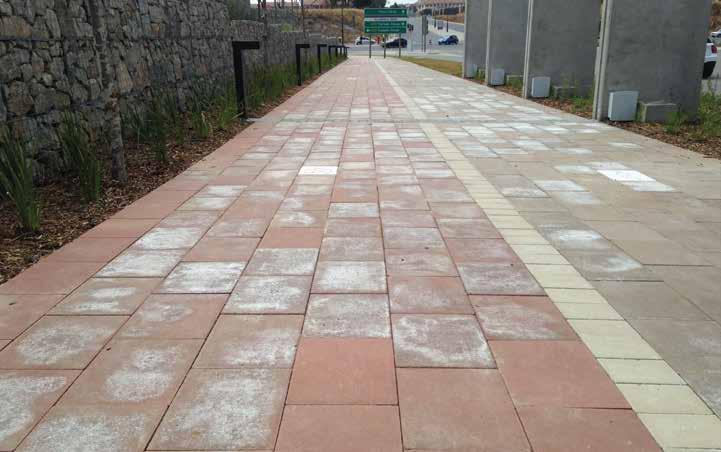
6 minute read
Maintenance
Maintenance of Bosun Dry Cast Concrete Pavers
Regular maintenance and good cleaning practices will enhance the overall appearance of your paving.
Advertisement
General cleaning of paving:
Regular hosing and sweeping with a hard-bristled outdoor broom will not only keep your paving looking clean, but will also prevent weeds from taking root, as they usually grow where seeds are left undisturbed to germinate in the debris that accumulates between the pavers. If the paving is heavily soiled, use a general-purpose pH-neutral/slightly alkaline, non-abrasive cleaner. Ensure that all the soap has been thoroughly removed from the surface after cleaning and that the run-off of soapy water is channelled to drainage points or containers where it can be disposed of safely.
Note: Do not use power hoses to clean paving, as this may wash out jointing sand and damage the grouting between pavers, ultimately damaging the pavers themselves.
Detergents:
Bosun recommends specialised products like Tile and Floor Care (www.tfc.co.za). It is essential to seek expert advice and guidance. Bosun cannot accept any responsibility for inappropriate use and application of detergents.
Mechanical cleaners:
It is recommended that sections of paving, at least, be cleaned daily in commercial pedestrian areas such as shopping centre piazzas and walkways. We also recommend the use of specialised equipment for daily maintenance of large paved areas. Tennant cleaning equipment is a respected option. We strongly advise you to consult an industry expert about the equipment which should be used on your site. Bosun cannot be held responsible for use of the wrong cleaning equipment.
The following recommendations relate to sweeping machines and associated equipment and their use:
• Equipment should be custom-designed for sweeping a particular area. If there is any doubt, the equipment manufacturer should be consulted. • Tyres should be inflated according to the manufacturer’s recommendations to ensure maximum weight distribution. • Polypropylene, rather than wire brushes should be used.. • The brush pressure of the sweepers should be set to the minimum requirement for the particular task, ie surfaces swept regularly will require a lower setting than those swept infrequently or those covered with heavy deposits. • When sweeping, engine revolutions should be set to the minimum requirement to maintain vacuum (suction) pressure. • Operators, including temporary staff, should be trained according to the vehicle manufacturer’s recommendations. Tyre and brush pressures should be checked regularly. • Operators should be advised to switch off suction, brush rotation and water jetting equipment when machinery is stationary or left unattended, to avoid the risk of damage to the area underneath the equipment. • In new or re-laid areas, allowance must be made for the pavement to settle and the joints to seal before cleaning manually. • When using water jetting equipment to wash such areas, the jet or hand-held lance should be directed diagonally at the surface (ie not parallel to joints) at an angle of no more than 30°, using a suitable detergent solution. • The area should be inspected after cleaning to refill joints with jointing sand, if necessary.
Stain removal and spot treatments:
Oil stains: As soon as the stain appears, dab excess spillage with an absorbent cloth or towel. Then remove the stain with soap, water and a brush. Ensure that all residue is washed away with hot water. Scuff marks from vehicle tyres: These marks can normally be removed by scrubbing the area with hot water and a strong detergent. Remember to rinse thoroughly. Rust stains, concrete, plaster and paint marks: Call in a cleaning professional to remove these particular marks on your paving, as attempting to do so yourself could cause damage to the surfaces. Beverage, smoke, fire and tobacco stains: These can normally be removed by scrubbing with hot, soapy water. If the stain is persistent, apply a mild bleach solution and then rinse the area with clean water, taking care to dispose of the run-off safely.
Weeds:
It is a common misconception that weeds grow from beneath paving. This may occur in rare instances, but weeds almost always grow from seeds and bird droppings which land in the paving joints. Regular hosing and sweeping of the paved area will dislodge newly emerging weeds before they become fully established.
Maintenance tips:
Inspect paving on a quarterly basis: Check for any loose, damaged or stained paving, as well as ensuring that the jointing material is intact. Loose paving: It is important to rectify the cause of the paving’s movement. Subsiding of the substrate layers is the most common cause of pavement failure. No matter what the cause, it needs to be investigated and rectified before replacing or re-bedding the pavers. Damaged or stained paving: Individual blocks can easily be replaced. See the Bosun website for further information on how to re-lay damaged paving. Jointing material that is no longer intact: The pavers simply need to be topped with jointing sand. This can be done by brushing or sweeping in approved dry plaster sand, where necessary.
Maintaining paving during construction:
Paving should be kept covered during construction or renovation in order to avoid damage and possible staining from paint- or oil-based substances, as well as any harsh chemicals.
Sealing of block paving:
Bosun recommends Cretesol. (www.cretesol.co.za). It is advisable to seek expert advice from an industry specialist. Bosun cannot accept any responsibility for inappropriate use or incorrect application of sealants. We strongly recommend that concrete products only be sealed six months after installation in order for them to fully cure on site and for possible efflorescence to run its course. It must be noted that sealants may have an effect on the colour of the paving and its slip/skid resistance. Sealants may also require ongoing maintenance during the life of the paving. In addition, it is important to ensure that the surface is dry, clean and efflorescence-free before any sealer is applied.
Benefits of sealing your paving:
• It improves its appearance. • In certain circumstances, sealing prolongs the paving’s life. • It helps seal the jointing material. • It inhibits weed growth. • It helps prevent stains (especially oil-based ones). • If you choose to apply a sealant to your paving, call in a paving specialist to do the job.
Efflorescence:
The white film that might appear on the surface of concrete, clay and natural stone products is called efflorescence. Apart from its discolouration, efflorescence is harmless. It is best described as a “temporary skin problem”, rather than a deep-seated disease.
How does it occur? Efflorescence is a natural phenomenon which occurs through a complex chemical or physical process, or a combination of the two. Detailed information on efflorescence is available on the Internet, or consult the Concrete Manufacturers’ Association website (www.cma.org.za).
Bosun’s take on efflorescence We are not bigger than nature. Bosun therefore cannot guarantee efflorescence-free products (either pre- or post-installation). We are constantly experimenting with aggregates and additives which might minimise or prevent efflorescence, although the soil beneath the paving could be the real reason this occurs.
The Cure We believe that the best cure for efflorescence is simply to leave it, as it will eventually disappear.
Experience has taught us that some paving installations have had efflorescence for only a few weeks, while others have been affected for months. Sometimes efflorescence is recurring and in other cases, it appears only once. It is therefore impossible to predict the outcome of a specific site. What we do know, however, is that efflorescence is temporary.
If you Google “Remove efflorescence”, about 260 000 results appear. Most of them recommend washing the affected material with a weak acid solution. However, the efflorescence could reappear within a day. As noted above, one cannot control natural forces.
Bosun believes that the use of acid is not a risk worth taking. However, if you do so, we recommend consulting the following British website page, for an objective and very comprehensive take on efflorescence, as well as options for removal:








